The Neuroscience Of Revenge

The neuroscience of revenge tells us that there are people who, far from turning the page after a disappointment, a rejection or what they interpret as an injustice, feed that hatred until they plan a way to strike back. Thus, far from controlling anger, rationalizing it or making use of adequate regulatory mechanisms, they allow that discomfort to become chronic.
Talking about revenge, as we well know, is sometimes complicated and it is difficult not to go into ethical, moral and even legal aspects. There are acts that obviously need a type of response, but in those cases who must apply justice will be the courts and never violence. However, in this article what interests us is to delve into the neurological and psychological aspects.
Let’s take an example. Those with a fondness for following criminal literature will undoubtedly remember the name of Ted Bundy. He was one of the worst serial killers in history, and to this day, it is still not known exactly how many victims he killed. After a series of interviews, psychological and neurological tests, something more than a psychopathic personality was discovered.
Bundy killed large numbers of young men out of a years-long desire for revenge. The origin (or trigger of their behavior) was the abandonment suffered by an emotional partner. That rejection fueled an inordinate and almost savage rage in him. His anger caused him to search for victims with the same physical characteristics as the girl who abandoned him.
Revenge, as we see, can act in certain people as a clearly aggressive and brutal mechanism. At present, neuroscientists have already discovered the mechanisms and areas that regulate this type of drive. It is such an interesting and revealing subject. Let’s see more data on the subject.

The neuroscience of revenge
If they insult us … shouldn’t we take revenge? Shakespeare said in one of his plays. Everyone at some point in our life has experienced that same sensation. After suffering an affront or a bad act on the part of someone, it is almost inevitable not to want to return to the other person the damage suffered. Feeling it like this and experiencing even that desire is neurologically and emotionally normal.
However, most of us rationalize the situation and after a stage of reflection and proper emotional management, we hold ourselves back and turn the page. This last process, the one that regulates and extinguishes the desire for revenge, is mediated by our cerebral cortex. Here, and specifically in the dorsolateral prefrontal area (DLPFC), our self-control processes are activated.
Now … what happens with those people characterized by a vengeful personality?
The wound of rejection and injustice
The University of Geneva conducted an interesting study at the beginning of 2018. The neuroscience of revenge now has very solid evidence that shows us several very striking aspects.
- Normally when we talk about this type of behavior it is common to refer to processes such as anger and rage. However, what causes the appearance of these types of emotions? The trigger for most acts of revenge seems to be rejection.
- Rejection is that anguished feeling where a person feels separated from something that, until recently, was meaningful to them. It can be a couple, a job, feeling separated from a family group or a certain group, from what one understands as “justice” or you can even experience that society itself is failing you.

Where is the drive for revenge located?
Dr. Olga Klimecki-Lenz, a researcher at the Swiss Center for Affective Science in Switzerland (CISA) located that area where our vengeful drives are concentrated, so to speak.
- That structure that activates the feeling of anger is an old acquaintance: the amygdala.
- Thanks to a series of magnetic resonance imaging tests, it could be seen at an experimental level, how this small structure is activated when we experience an affront, a slight, a deception and the pain of rejection.
- It should be said that, in this type of situation, what we feel in the first place is “fear”.
- That feeling of security and trust that we had about something or someone until not long ago is broken, and instantly, fear, anguish arises. After this, anger and the urge to carry out some kind of punishment appear.
- That punishment also establishes a reward system. In other words, the person can feel “pleasure” in taking revenge and applying the same affront suffered to oneself on others.
- On the other hand, together with the amygdala, the upper temporal lobe is also activated. These two areas intensify that need to shape a vindictive act. However, the most interesting thing happens later.
- When these two structures are activated, prominent activity soon arises in the dorsolateral prefrontal cortex. The reason? To appease emotional intensity and promote self-control.
This last data undoubtedly opens up the interesting possibility of reducing violent and retaliatory acts through magnetic stimulation. However, as we well know, aggressive behaviors, such as those that characterized the serial killer Ted Bundy, depend on many more factors that are not always explained by neurobiological factors.
The fascination with the psychology of revenge
From a cultural and even psychological point of view, revenge is an interesting dimension. There we already have masterpieces such as The Count of Monte Cristo , where Alexander Dumas showed us that revenge is served cold and can take years to be executed. However, we must not overlook an essential aspect. People who carry out this type of behavior on a regular basis show a fact that scientists such as Kevin M. Carlsmith, Timothy D. Wilson and Daniel T. Gilbert have demonstrated: lack of empathy.
Even more, if we ask ourselves why there are profiles characterized by that almost constant need to make the rest pay for what they consider to be “injustices”, psychology tells us that they almost always respond to the same pattern: they are narcissistic, insecure people, with low emotional regulation, no capacity to forgive and lack of empathy.
To conclude, it is worth reflecting for a moment on a very simple idea: we have all felt at some point the prick of the desire for revenge. However, the decision to remain calm and prudent is what makes us human, what makes us noble.









